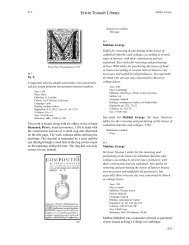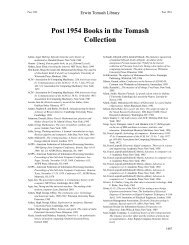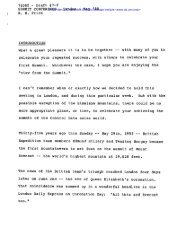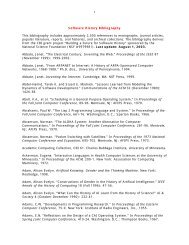B chapter.indd - Charles Babbage Institute - University of Minnesota
B chapter.indd - Charles Babbage Institute - University of Minnesota
B chapter.indd - Charles Babbage Institute - University of Minnesota
You also want an ePaper? Increase the reach of your titles
YUMPU automatically turns print PDFs into web optimized ePapers that Google loves.
Erwin Tomash Library<br />
Bramer, Benjamin Bramer, Benjamin<br />
Joost Bürgi, B 226<br />
clock and instrument maker Joost (Jobst) Bürgi. He<br />
spent five years with Bürgi at the imperial court in Prague,<br />
returning to Kassel in 1604. In 1612, he was appointed<br />
master builder in the court at Marburg. He is known<br />
for earlier publications on mathematics and surveying<br />
instruments that are almost unique in that he credits his<br />
predecessors (including Bürgi) with the ideas he expands<br />
upon—this in an era in which most instruments makers<br />
were very secretive about their sources and techniques.<br />
In this work Bramer continues his unusual<br />
acknowledgement <strong>of</strong> the work <strong>of</strong> his predecessors,<br />
particularly Bürgi, whose portrait appears in the<br />
frontispiece. Leone Battista Alberti (1435), Albrecht<br />
Dürer (1525) and Joost Bürgi (1604) had each<br />
investigated the problem <strong>of</strong> how to create an instrument<br />
that would allow one to produce accurate geometric<br />
perspective drawings. Bramer continued this tradition<br />
by developing his own set <strong>of</strong> instruments, particularly<br />
one to draw conic sections. The device was evidently an<br />
improvement on one devised by Christoph Scheiner.<br />
After describing conic curves and instruments for<br />
drawing ellipses, Bramer introduces his universal conic<br />
instrument and then illustrates its use. The latter part <strong>of</strong><br />
the book is mainly concerned with the production <strong>of</strong><br />
sundials on all orientations <strong>of</strong> surfaces—a process that<br />
makes use <strong>of</strong> many conic section curves.<br />
Illustrations available:<br />
Title page – color<br />
Frontispiece – Joost Bürgi portrait<br />
Conic instrument<br />
B 227<br />
Bramer, Benjamin (ca.1588–1650)<br />
Bericht und gebrauch Eines Proportional Linials:<br />
Neben kurtzem Underricht Eines Parallel Instruments<br />
Year: 1617<br />
Place: Marburg<br />
Publisher: Paul Egenolff<br />
Edition: 1st<br />
Language: German<br />
Figures: 3 engraved plates, (2 folding)<br />
Binding: modern full morocco<br />
Pagination: pp. 58<br />
Collation: A–G 4 H 1<br />
Size: 189x149 mm<br />
Reference: Cro CL, #133<br />
Bramer’s sector, one <strong>of</strong> the three main instruments<br />
described in this work, is interesting for its use <strong>of</strong> a<br />
removable arm, hinged with a pin through a hole at the<br />
end <strong>of</strong> each scale, which avoids the problem <strong>of</strong> making<br />
a complex hinge. This innovation also allowed him to<br />
construct each scale on an individual line, thus avoiding<br />
the problem <strong>of</strong> interfering scale graduations near the<br />
hinge (where all scales come together at a point in the<br />
Hingeless sector, B 227<br />
191







